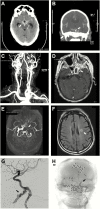Invasive Fungal Carotiditis: A Rare Manifestation of Cranial Invasive Fungal Disease: Case Series and Systematic Review of the Literature
- PMID: 31660355
- PMCID: PMC6790399
- DOI: 10.1093/ofid/ofz392
Invasive Fungal Carotiditis: A Rare Manifestation of Cranial Invasive Fungal Disease: Case Series and Systematic Review of the Literature
Abstract
Background: Rhinosinusitis, malignant otitis externa, and skull base osteomyelitis represent a spectrum of cranial invasive fungal disease (IFD). These syndromes have distinct characteristics, yet they may progress to involve similar structures, resulting in inflammation and invasion of the adjacent internal carotid artery (ICA). Invasive fungal carotiditis can have devastating consequences, including cerebral infarction, subarachnoid hemorrhage, and death.
Methods: We retrospectively studied all patients diagnosed with cranial IFD and carotid involvement at our institution from 2003 to 2018. We also searched Medline/PubMed for reports of Aspergillus or Mucorales cranial infections with ICA involvement. All cases with mycologic evidence of cranial IFD and radiographic or pathologic evidence of ICA involvement were included.
Results: We identified 78 cases of invasive fungal carotiditis between 1958 and 2018, including 4 cases at our own institution. Forty-one were caused by Aspergillus and 37 by Mucorales species. Presenting symptoms included vision changes (73%), cranial nerve palsy (69%), and headache (42%). Carotid events included occlusion, aneurysm formation, and vessel rupture. Cerebral infarcts occurred in 50% of cases. Mortality at 6 weeks, 12 weeks, and 2 years was 27%, 41%, and 71% respectively. The median time from symptom onset to death was 150 days for cases due to Aspergillus and 51 days for cases due to Mucorales species.
Conclusions: Invasive fungal carotiditis is a rare but morbid manifestation of cranial IFD. Early suspicion of IFD and administration of antifungal treatment, vascular imaging, and endovascular interventions should be considered to reduce the high mortality of this disease.
Keywords: aspergillosis; carotid artery; invasive fungal disease; mucormycosis.
© The Author(s) 2019. Published by Oxford University Press on behalf of Infectious Diseases Society of America.
Figures


References
-
- Petrikkos G, Skiada A, Lortholary O, et al. . Epidemiology and clinical manifestations of mucormycosis. Clin Infect Dis 2012; 54(suppl_1):S23–34. - PubMed
-
- Reischies F, Hoenigl M. The role of surgical debridement in different clinical manifestations of invasive aspergillosis. Mycoses 2014; 57(Suppl 2):1–14. - PubMed
-
- Blyth CC, Gomes L, Sorrell TC, et al. . Skull-base osteomyelitis: fungal vs. bacterial infection. Clin Microbiol Infect 2011; 17:306–11. - PubMed
LinkOut - more resources
Full Text Sources
Miscellaneous

